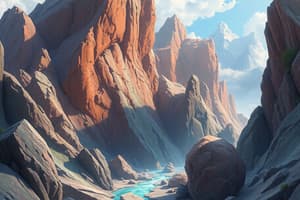Podcast
Questions and Answers
What is the main characteristic of intra-clasts particles?
What is the main characteristic of intra-clasts particles?
They are fragments of calcium carbonate material that has been partly lithified and then broken up and reworked to form a clast.
What are aggregate grains, and how do grapestones differ from them?
What are aggregate grains, and how do grapestones differ from them?
Aggregate grains are carbonate grains consisting of several fragments cemented together. Grapestones are a type of aggregate grain that comprises a collection of rounded grains.
What is the primary criterion used in the Dunham classification scheme for carbonate sedimentary rocks?
What is the primary criterion used in the Dunham classification scheme for carbonate sedimentary rocks?
The texture, described in terms of the proportion of carbonate mud and granules present and how the rock's components interconnect with each other.
What is the main difference between a packstone and a grainstone in the Dunham classification?
What is the main difference between a packstone and a grainstone in the Dunham classification?
What is the definition of a floatstone in the Dunham classification?
What is the definition of a floatstone in the Dunham classification?
What are the main types of carbonate rocks?
What are the main types of carbonate rocks?
What are the principal sources of calcium carbonate in the natural environment?
What are the principal sources of calcium carbonate in the natural environment?
What is the difference between ooids and pisoids?
What is the difference between ooids and pisoids?
What is the characteristic feature of peloids?
What is the characteristic feature of peloids?
What are the exceptional cases of carbonate rocks that are not sedimentary in origin?
What are the exceptional cases of carbonate rocks that are not sedimentary in origin?
Flashcards are hidden until you start studying
Study Notes
Carbonate Rocks
- The main types of carbonate rocks are limestone, dolomite, and aragonite.
- Calcium carbonate is primarily sourced from the hard parts of organisms, mainly invertebrates such as mollusks.
Limestones
- Limestones make up 10-15% of sedimentary rocks.
- Limestone consists of three components: grains, matrix, and cement.
- There are two types of grains: non-skeletal and skeletal.
Non-Skeletal Grains
- Ooids:
- Spherical bodies of calcium carbonate less than 2mm in diameter.
- Formed by chemical precipitation in agitated water saturated with calcium carbonate in warm waters.
- Have an internal structure of concentric layers around a nucleus.
- Pisoids (Pisolites):
- Concentrically layered carbonate particles over 2mm across.
- Often more irregular in shape.
- Oncoids:
- Concentrically layered carbonate particles over 2mm across.
- Less regular lamination than ooids and pisoids.
Skeletal Grains
- Peloid (Pellet):
- Fine-grained calcium carbonate.
- No concentric structure.
- Commonly faecal pellets of marine organisms.
- Dimensions: 0.04 to 0.08 mm.
- Intra-clasts particles:
- Fragments of calcium carbonate material that has been partly lithified and then broken up and reworked.
- Aggregate grains and grapestones:
- Carbonate grains consisting of several fragments cemented together.
- Grapestones are aggregate grains comprising a collection of rounded grains.
Matrix and Cement
- Matrix:
- Consists of calcareous particles with diameter 0.06-2mm.
- Mechanically deposited.
- Cement:
- Micrite: < 4 um.
- Micro-Sparite: 4-20 um.
- Sparite: >20 um.
Classification of Limestone
- According to grain size:
- Calci-rudite: > 2mm.
- Calci-arenite: 64 um-2mm.
- Calci-lutite: < 64 um.
- Dunham Classification:
- Primary criterion: texture.
- Classified into: carbonate mudstone, wackestone, packstone, grainstone, boundstone, floatstone, and rudstone.
- Based on the proportion of carbonate mud and granules, and how the rock components interconnect.
Studying That Suits You
Use AI to generate personalized quizzes and flashcards to suit your learning preferences.





